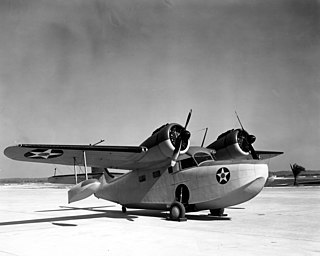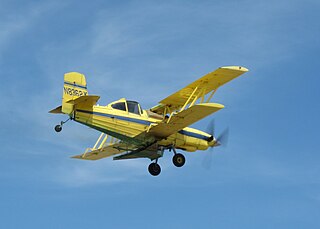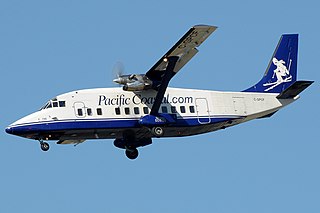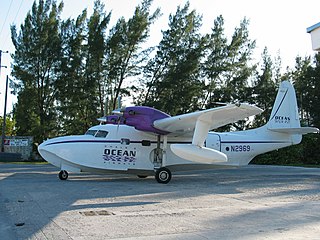
The Airspeed AS.57 Ambassador is a British twin piston-engined airliner that was designed and produced by the British aircraft manufacturer Airspeed Ltd. It was one of the first postwar airliners to be produced.

The Vickers Viscount is a British medium-range turboprop airliner first flown in 1948 by Vickers-Armstrongs. A design requirement from the Brabazon Committee, it entered service in 1953 and was the first turboprop-powered airliner.

The Cessna 208 Caravan is a utility aircraft produced by Cessna. The project was commenced on November 20, 1981, and the prototype first flew on December 9, 1982. The production model was certified by the FAA in October 1984 and its Cargomaster freighter variant was developed for FedEx. The 4 ft (1.2 m) longer 208B Super Cargomaster first flew in 1986 and was developed into the passenger 208B Grand Caravan.
Chalk's International Airlines, formerly Chalk's Ocean Airways, was an airline with its headquarters on the grounds of Fort Lauderdale-Hollywood International Airport in unincorporated Broward County, Florida near Fort Lauderdale. It operated scheduled seaplane services to the Bahamas. Its main base was Miami Seaplane Base (MPB) until 2001, with a hub at Fort Lauderdale-Hollywood International Airport. On September 30, 2007, the United States Department of Transportation revoked the flying charter for the airline, and later that year, the airline ceased operations.

The Grumman G-21 Goose is an amphibious flying boat designed by Grumman to serve as an eight-seat "commuter" aircraft for businessmen in the Long Island area. The Goose was Grumman's first monoplane to fly, its first twin-engined aircraft, and its first aircraft to enter commercial airline service. During World War II, the Goose became an effective transport for the US military, as well as serving with many other air forces. During hostilities, the Goose took on an increasing number of combat and training roles.

The de Havilland Canada DHC-3 Otter is a single-engined, high-wing, propeller-driven, short take-off and landing (STOL) aircraft developed by de Havilland Canada. It was conceived to be capable of performing the same roles as the earlier and highly successful Beaver, including as a bush plane, but is overall a larger aircraft.

The Harbin Y-12 is a high wing twin-engine turboprop utility aircraft built by Harbin Aircraft Industry Group (HAIG).

The de Havilland Canada DHC-7, popularly known as the Dash 7, is a turboprop-powered regional airliner with short take-off and landing (STOL) performance. It first flew in 1975 and remained in production until 1988 when the parent company, de Havilland Canada, was purchased by Boeing in 1986 and later sold to Bombardier. In 2006 Bombardier sold the type certificate for the aircraft design to Victoria-based manufacturer Viking Air.

The Beechcraft 1900 is a twin-engine turboprop regional airliner manufactured by Beechcraft. It is also used as a freight aircraft and corporate transport, and by several governmental and military organizations. With customers favoring larger regional jets, Raytheon ended production in October 2002.

The Grumman G-164 Ag Cat is a single-engined biplane agricultural aircraft, developed by Grumman in the 1950s.

The Short 360 is a commuter aircraft that was built by UK manufacturer Short Brothers during the 1980s. The Short 360 seats up to 39 passengers and was introduced into service in November 1982. It is a larger version of the Short 330.

The Grumman Gulfstream I is a twin-turboprop business aircraft. It first flew on August 14, 1958.

The Beechcraft Model 99 is a civilian aircraft produced by Beechcraft. It is also known as the Beech 99 Airliner and the Commuter 99. The 99 is a twin-engine, unpressurized, 15 to 17 passenger seat turboprop aircraft, derived from the earlier Beechcraft King Air and Queen Air. It uses the wings of the Queen Air, the engines and nacelles of the King Air, and sub-systems from both, with a specifically designed nose structure.

Chalk's Ocean Airways Flight 101 was an aircraft crash that occurred off Miami Beach, Florida, in the United States on December 19, 2005. All 18 passengers and the 2 crew members on board the 1947 Grumman G-73T Turbine Mallard died in the crash, which was attributed to metal fatigue on the starboard wing resulting in separation of the wing from the fuselage.

The Aérospatiale N 262 is a French twin-turboprop high-wing airliner built first by Nord Aviation. The aircraft was also known as the Nord 262.
Pearl Aviation is an Australian aviation company that operates charter and medical evacuation flights, as well as navigational aid flight inspection services, flight centres and ground handling. It is part of the Paspaley Group. Its main base and flight centre is Darwin International Airport.
Charlotte Amalie Harbor Seaplane Base, also known as St. Thomas Seaplane Base, is located in the harbor by Charlotte Amalie, Saint Thomas, U.S. Virgin Islands. This private-use airport is owned by the Virgin Islands Port Authority.
Christiansted Harbor Seaplane Base, also known as St. Croix Seaplane Base, is located in the harbor by Christiansted, Saint Croix, U.S. Virgin Islands. This private-use airport is owned by the Virgin Islands Port Authority. The sea base is home to Seaborne Airlines U.S. Virgin Islands, the only multi-engine sea plane airline operating in the United States.

The Swearingen Merlin or the Fairchild Aerospace Merlin is a pressurized, twin turboprop business aircraft first produced by Swearingen Aircraft, and later by Fairchild at a plant in San Antonio, Texas.
Miami Seaplane Base is a public-use seaplane base located 2 miles (3.2 km) east of the central business district of Miami on Watson Island in Miami-Dade County, Florida, United States.



















